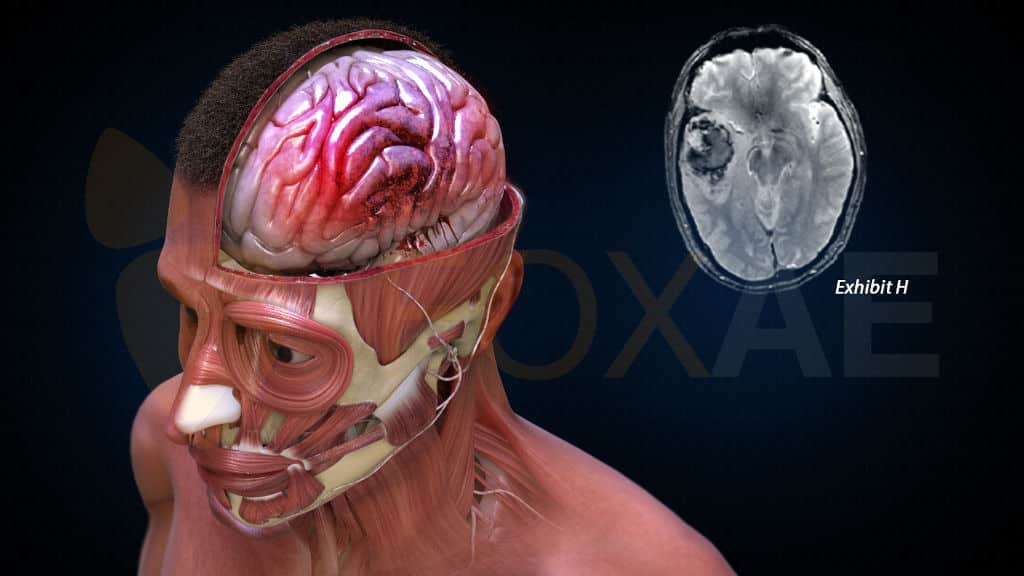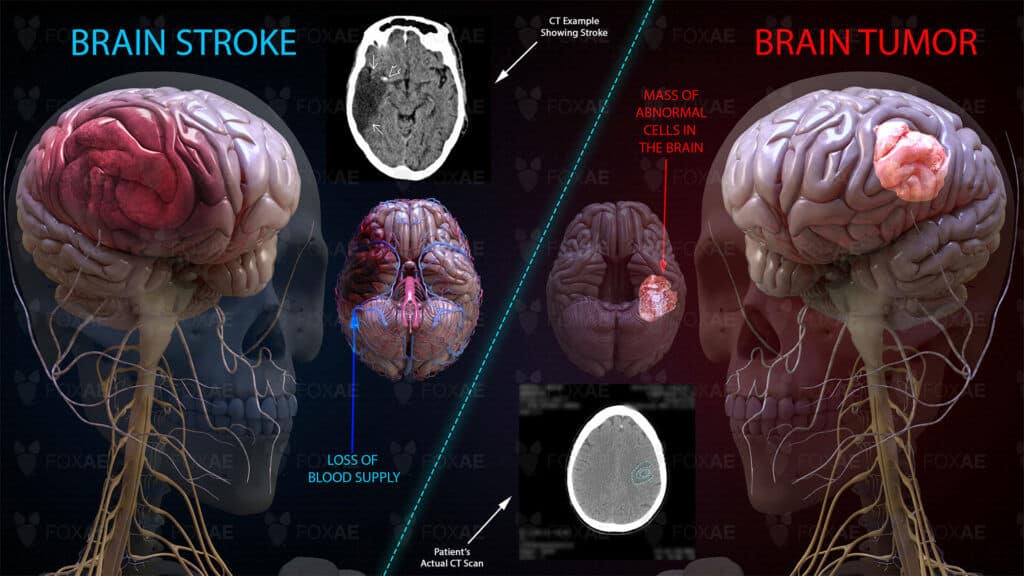Brain herniation, also known as cerebral herniation, is a potentially fatal side effect of extremely high pressure within the skull. This happens when a section of the brain is forced across structures within the skull.
It happens when brain tissue, blood, and cerebrospinal fluid (CSF) slip from their usual location inside the skull.
During a herniation, the brain can move along various structures in the skull. It can move from one side to the other, down, under, or across a rigid membrane such as the tentorium cerebelli or falx cerebri.
It could also move through the foramen magnum, a natural bony opening at the base of the skull.
In other instances, it can move through openings created during brain surgery, such as those created after tumor removal.
Brain herniation is a medical emergency that should make a person call 911 immediately after noticing symptoms. If it isn’t treated or managed immediately, it can lead to permanent neurological disabilities and sometimes fatalities.
This is why it is not at all surprising that brain herniation cases are instituted in court yearly in such large numbers.
This brain injury can be caused by various circumstances, such as medical malpractice, negligence, or even traumatic events.
For instance, the latest data on traumatic brain injuries from the Centers for Disease Control and Prevention states that there were approximately 223,135 TBI-related hospitalizations in 2019. 64,362 TBI-related deaths were also recorded in 2020.
Consequently, whatever may cause a brain herniation, there is a court action perfectly suited to ensure that justice is served.
Moreso, medical animation can help in all of these legal actions to help illustrate the injury before a court of law.

Brain Herniation, Assault, and Legal Animation
When a brain herniation is caused by an injury to the head, usually by a direct assault, the case would be brought by way of assault.
For an assault to result in brain herniation, the assaulter must have thrown a punch to the victim’s head or hit their head with a solid object. The assaulter may also hit the victim’s head against a wall, the floor, or a solid surface around.
The head injury from the assault may lead to a subdural hematoma, a condition where blood collects on the brain’s surface beneath the skull.
A case in point is Johnson v. State. In this case, a child died after being found not breathing, and efforts to resuscitate her failed. The radiologist later discovered from the autopsy that she suffered multiple blunt traumas to her head and face. This caused swelling around her eyes, a torn frenulum, a laceration to her spleen, liver hemorrhages, subdural hematomas in the back of the head, and a brain herniation.
The court subsequently ruled that the child was a victim of child abuse and homicide, holding the appellant liable.
Apart from a subdural hematoma, the injury may also cause cerebral edema, which is essentially a swelling.
Both of these conditions can progress into a brain herniation in a matter of hours.
Now, what’s the function of a legal animation in all of these?
It’s pretty simple.
The progressive nature of the assault and its result, then brain herniation, will be shown step by step.
Therefore, first, there will be the visualization of the assault and the force exacted on the plaintiff’s head. The animation will show the head’s anatomy and the punch’s direct and immediate effect on the head.
Following that, the injury is further visualized, showing the minute-by-minute progress of the injury into a herniation. Any other debilitating impact on the entire body can also be illustrated.
With this type of visualization, the plaintiff can fuel the jury’s empathy and understanding of who is at fault and how it has gravely affected the victim.
It also gives an overview of the injury and the extent to which it affects the plaintiff now and in the future. This will strongly affect the compensation structure.
Brain Herniation, Personal Injury Car Accident Liability Claim, and Legal Animation
After a car accident, it is possible to institute a personal injury car accident liability claim. This process can be made easier with the help of legal animation.
A traumatic brain injury is one of the possible injuries from a car crash. This has a direct impact on causing brain herniation.
Just like in assault, an injury to the head can lead to a subdural hematoma, cerebral edema, and many other injuries that can cause a herniation. In such a case, it is essential to consider the use of legal animation.
A legal animation involving a brain herniation will commence by showing who the at-fault driver was during the car crash.
Thus, the vehicles themselves will first be animated to point out which driver failed to obey traffic rules, thus causing the crash.
Secondly, the animation will show the impact and how it caused the plaintiff to hit their head against a hard surface. Immediately, the anatomy of the head will be illustrated while showing the resultant effect of the impact on the brain.
The animation will then showcase how the injury progressed into a brain herniation.

Brain Herniation, Medical Malpractice, and Medical Animation
At other times, brain herniation can arise from medical malpractice. Medical negligence can affect the brain in various ways, causing herniation.
Firstly, it could be the result of a wrongful diagnosis.
Usually, the symptoms of a brain herniation include high blood pressure, an irregular or slow pulse, a severe headache, weakness, cardiac arrest (no pulse), loss of consciousness, coma, loss of all brainstem reflexes, respiratory arrest, wide (dilated) pupils, and a lack of movement in one or both eyes.
Therefore, a medical practitioner should be able to suspect a herniation when a couple of these symptoms are noticed. A plaintiff can have a case if the delay causes the herniation to lead to deformities.
A case in point is that of a female patient who suffered paralysis due to a delayed diagnosis of brain herniation. The major contention of the defendant was that a late or early diagnosis would have had no effect on the realized outcome either way.
The case was decided in favor of the plaintiff with an award of $10.7 million in compensation.
With the use of medical animation, the plaintiff can showcase the progression of the herniation. It can illustrate how the situation could have been saved if the diagnosis had not been delayed or wrong.
Additionally, a doctor can commit medical malpractice while treating a brain herniation.
For instance, many errors can occur while treating brain herniation relating to cerebrospinal fluid (CSF) with a shunt. The shunt may be contaminated or overdrain the CSP. This leaves the patient with torn blood vessels, leading to hemorrhages, headaches, or brain ventricle collapse.
These medical malpractices can be illustrated through the use of medical animation.

Brain Herniation, Negligence, And Legal Animation
Sometimes, negligence may be due to a brain herniation. That is, the person liable may not have had any malicious intent against the plaintiff but failed to carry out a vital function that would protect people from harm.
Thus, a slip and fall or workplace accident may cause brain herniation due to the negligence of the owner of the premises.
Just like in the case above, where the plaintiff suffered paralysis due to a delayed diagnosis of brain herniation, a premises liability case may follow suit.
In that case, the injury that caused the herniation was from a fall down the staircase in her house. She recovered $3 million in a claim for premises liability.
Conclusion
From all that has been considered above, it is very clear that the type of court claim that accompanies a brain herniation does not limit the use of legal animation but only amplifies it.
With medical animation, different aspects can be illustrated, such as the cause of the herniation and its treatment. This will help give the court an insider’s view of the case.
Therefore, looking out for a legal animation company well-versed in animating medical cases and helping win such cases is pertinent.
Fox-AE is a litigation animation company famous for mind-blowing, precise, and accurate medical animation exhibits. These exhibits are created by our expert medical animators. They collaborate with qualified expert witnesses to help validate the process and give more insight into the case.






